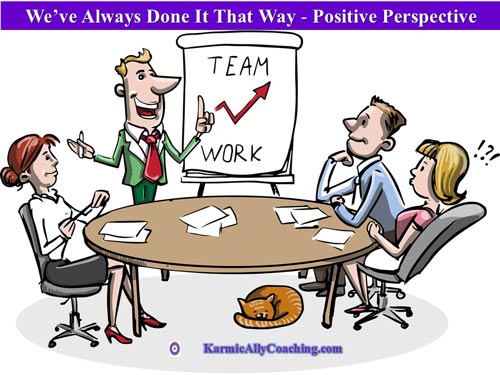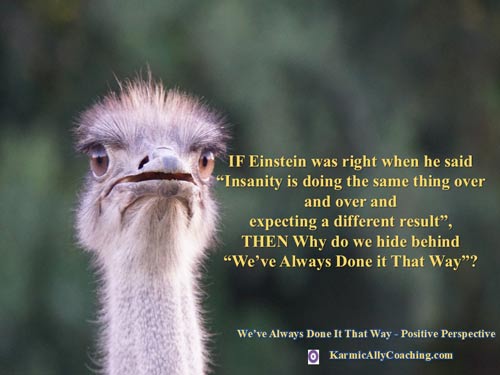This post has already been read 2644 times!

If you’ve ever tried to introduce change in an organization or department, then hearing the phrase ‘we’ve always done it that way’ or ‘that’s the way we’ve always done it’ will irritate you- guaranteed!
You would be fully justified to think the employees are hiding their incompetence or are disengaged.
Sometimes, it’s the insecurity in the staff. They feel that if change is introduced, it would make them redundant or replaceable especially if the knowledge they possess isn’t available with anyone else in the department. I’ve seen that happen too.
But pause for a moment, it’s quite possible the person saying it isn’t defending a time inefficient task, they genuinely might not know of an alternative.
Contrary to the ranting I often see on the internet about people defending archaic or redundant processes because they are scared of change, sometimes, it’s the team that wants change or is open to new processes. But they don’t have a teacher or leader who can help them create a new status quo.
I used to think the same way until I took on a project where to my surprise, the employees asked me to implement a new way of doing things to make their lives easier!
True Story: How a secret bar stock room became an authorized storage room
Way back in the late 1990s when I was working as a consultant to a leading Adventure Group of Companies in Nepal, one of my jobs was to visit their Lodges and check for efficiency and productivity. The mandate was to strengthen the controls over food and beverages since we knew there was a leak somewhere.
You can read the background in my post Internal Controls: To catch Thieves, You need to think like one.
The employees at the first Lodge I visited were eager to co-operate with my audit exercises and wanted to plug the ‘leak’ too since they knew it was an area of complaint from Headquarters.
They asserted their innocence and instead of seeing me as the enemy from Headquarters, took my 2 week visit as an opportunity to create change.
They loved their employer, were loyal to a fault and welcomed my visit.
Interesting discoveries were made including a secret storeroom kept by the Bar Keeper who was unaware of the fact that all stock had to be kept in the centralized storeroom.
His explanation based on my observations made sense.
The tourists who came to the Lodge loved to drink at the fireside and there were times when he would run out of stock, so he kept a bottle or two in the so-called secret storeroom.
Sadly, despite having an Internal Auditor for the Group as well as an external auditor, nobody had bothered to find out what was happening. The forms in use had been there since the beginning of time. (Side story: Both were fired after I submitted my report).
The secret storeroom was legitimized and included in stock takes and a few forms were updated for modern times.
A team of staff members even sat with me at a meeting they had called for to give suggestions to improve the systems and tighten controls.
Mind you, these were not finance specialists or educated, but they had decades of wisdom in lodge management and could have put any hotel management graduate to shame.
One point I noted was the answer to each question was “we’ve always done it that way”.

It reminds me of an anecdote I had read years ago which apparently is based on a true incident.
What happens when we don’t question procedures?
A quality management consultant was visiting a small and somewhat antiquated English manufacturing company, to advise on improving general operating efficiency.
The advisor was reviewing a particular daily report which dealt with aspects of productivity, absentee rates, machine failure, down-time, etc.
The report was completed manually onto a photocopied proforma that was several generations away from the original master-copy, so its headings and descriptions were quite difficult to understand.
The photocopied forms were particularly fuzzy at the top-right corner, where a small box had a heading that was not clear at all. The advisor was interested to note that the figure ‘0’ had been written in every daily report for the past year.
On questioning the members of staff who completed the report, they told him that they always put a zero in that box, and when he asked them why they looked at each other blankly. “Hmmm.., I’m not sure about that,” they each said, “I guess we’ve just always done it that way.”
Intrigued, the consultant visited the archives to see if he could find a clearer form, to discover what was originally being reported and whether it actually held any significance.
When he found the old reports, he saw that the zero return had continued uninterrupted for as far back as the records extended – at least the past thirty years – but none of the forms was any clearer than those presently in use. A little frustrated, he packed away the old papers and turned to leave the room, but something caught his eye.
In another box he noticed a folder, promisingly titled ‘master forms’. Sure enough inside it he found the original daily report proforma master-copy, in pristine condition. In the top right corner was the mysterious box, with the heading clearly shown …… ‘Number of Air Raids Today’.
How does this relate to you the leader of your people?
Not knowing when to make changes in procedures, routines and habits results in time wastage which is not what executives wanting to demonstrate leadership do.
Good managers and executives appreciate the value of their time. They understand it’s what we do with our time to benefit ourselves and others that determines how well they manage this precious resource.
They know how to manage their time and work on priority recommending changes to save time without compromising quality of work.
In other words, they position themselves as Leaders.
Here’s how we did it back in the Lodge:
Step 1: I didn’t have a procedure manual at hand so I recorded how certain processes were done by the staff in charge of those processes including who checked the work.
The staff helped me identify those parts of procedures that didn’t add value to their efforts. I suggested new ones based on my knowledge of internal controls and industry best practice.
Step 2: We looked at the tasks that were not adding value to check if they needed to be improved or simply dumped as the steps had been set up 25 years ago. We also checked if there was technology that could be implemented to reduce wastage.
Step 3: We monitored our results with the new processes and procedures.
My first visit was for only a fortnight but the staff knew I would return at a later date and they were asked to monitor if things were better.
A month later, when I visited the site to continue on another aspect of the systems, I had 800 very happy workers waiting to greet me.
There’s a more comprehensive and systematic way to set up an operations manual and systems in my course Business Systems that encourage Growth – Guaranteed.
More Tips to shine as a good Leader in the Workplace
Quite honestly, as a consultant I didn’t have locus standi to order the changes. Sometimes I had to rely on the Lodge Manager who was the owner’s son to instruct change implementation, especially about the secret bar stock room!
The success of this project would not have been possible if the employees were not “team players.”
You may hear that so often that it becomes meaningless. But it isn’t – being a team player is a fairly broad term, and it can include an important attribute that employers appreciate: leadership.
Being a leader in the workplace does not necessarily mean being a boss, manager, supervisor, or other “official” position, although it can mean that.
It can also mean setting a good example for others and/or heading up office programs and projects.

Here are some tips and ideas on how to be a leader in the workplace that I learned from my experience at the Lodge.
Be Confident
There’s a saying that can serve you well in the workplace: “Never let them see you sweat.” Of course, no one is perfect; but appearing confident inspires others to trust you and take your advice.
One way to ensure that you appear self-assured is not to talk too much about your fears and concerns. Talk to friends outside of the workplace about your uncertainties.
See the Good in Others
Being able to see the good traits in others is a useful leadership trait in the workplace. If you need to put certain people in charge of certain tasks, it pays to know who will do well with what task.
You also may see potential in a co-worker and “stretch” him or her by requesting a task that might be a bit challenging. This improves the overall skill set of the workforce and helps build self-esteem in your co-workers.
Use the skill of effective feedback in all situations requiring improvement.
Don’t Be Afraid to Delegate
There’s a difference between being a people person & being a people-pleaser. Being a people person means you have a genuine love for people, but you’re not afraid to ask people to do things.
Being a leader doesn’t mean just doing everything yourself; it means you are comfortable giving up some control and delegating tasks to others.
Appreciate Co-Workers
No one wants to work for or with someone who doesn’t appreciate them. If you let everyone know you appreciate what they’ve done and how they’ve given their time and talents, it can go a long way.
It’s always good to remember that there would be no leaders if there weren’t any followers. People who are appreciated may be more likely to follow your lead next time.
Problem Solving
If you step up with ideas on how to solve dilemmas, problems, and have resourceful ideas about how to accomplish something, then speak up. Employers value the ability to think through a problem and find a creative solution. This is a valuable leadership quality.
The next time you’re faced with the ‘we’ve always done it that way’ phrase, do what I did. Don’t generalize or misread any grumpy expression.
Instead try being a leader.





 I adhere to the Certified Coaches Alliance Code of Ethics and Standards. A copy is available on request.
I adhere to the Certified Coaches Alliance Code of Ethics and Standards. A copy is available on request.
 Let's Talk through the Connect Form:
Let's Talk through the Connect Form:
As I read your post… I am reminded of the fact that nothing really mind blowing can happen in our comfort zones.
Love this post!
Absolutely true, Zeenat. One might as well become an ostrich and hide our head in the sand at the first sign of positive change because we prefer doing things the way they’ve always been done, whether its good or bad.
Brilliant article, Vatsala. I’ve worked in a few places that wore “we’ve always done it this way” as a badge of honor. What a shame, their potential for expansion would have been phenomenal.
This is a great example of people coming together and willing to shift their ‘routines” to better their work environment on all levels. Listening, watching, evaluating and offering solutions. YES!
Thanks Cindy. People do wear this phrase like a badge of honor don’t they. Imagine how much could be achieved if people were open to change.
… and we may go back to doing things that way. But first we’re going to try this!
Thanks for posting.
Oh dear, I hope you mean the new way will become ‘that way’ Andrea. 🙂
Great article about how things can be done differently while respecting company boundaries in the workplace. This shows true leardership and your tips and ideas are so well-written!
Thank you Genevieve. Leadership based on knowledge, reference and a personal connection works best.
A very wise woman taught me that if you keep doing what you’ve always done, you’ll keep getting what you’ve always gotten. In other words, change the story first and the rest will follow.
Absolutely, Barbara. The same story always has the same ending. Change the story and the ending changes.
Presenting your ideas with love seems to work wonders. When it truly comes from your heart you are in a place of peace to present them instead of fighting the energy around it. Being closed off to change often prevents us from moving forward. At the very least you can put your thought out there, that in itself is change.
Love the topic of your post.
I agree with you, Heather. When we approach a problem or situation where both sides can help find a solution and where people feel their view and experience matters, we create a better solution and improve the probability of successful goal achievement. Thanks for adding your perspective to the conversation.